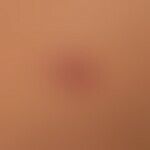Synonym(s)
HistoryThis section has been translated automatically.
Spiegler, 1894; Burckhardt, 1911; Bäfverstedt, 1943
DefinitionThis section has been translated automatically.
Benign, regressive, often (or exclusively?) Borrelia-induced, pseudolymphoma-like, nodular proliferation of the lymphoreticular tissue of the skin (pseudo-B-cell lymphoma of the skin) with a characteristic clinical picture.
You might also be interested in
PathogenThis section has been translated automatically.
In cases of Borrelia-induced lymphadenosis cutis benigna B. afzelii and B. garinii are detected. Both Borrelia species are not found in North America. Therefore these cases do not occur genuinely there.
EtiopathogenesisThis section has been translated automatically.
The clinical picture of lymphadenosis cutis benigna (lymphocytoma) is today primarily assigned to a Borrelia infection, as it frequently occurs in "reactive skin areas" (earlobes, nipples, genitals, etc.) in the course of an (already regressed) erythema chronicum migrans. Often a tick bite is no longer remembered. Borrelia infections can be reliably detected in 1/3 of the cases. In a larger Italian study, 7 cases (1%) of lymphadenosis cutis benigna occurred in 705 Borrelia-infected persons. However, 2/3 of the cases remain etiologically unexplained.
Pharmacological causes (drugs, essential oils, contact allergens-e.g. diphenylcyclopropenone ) are likely to be rare (causality is difficult to prove).
Etiologically unexplained cases are rather called pseudolymphomas of the skin.
ManifestationThis section has been translated automatically.
children and adolescents; young adults, rarely is a later age of manifestation
LocalizationThis section has been translated automatically.
Clinical featuresThis section has been translated automatically.
Mostly solitary, rarely multilocularly occurring, little sharply defined reddish, asymptomatic (no itching, no pain), also reddish-livid or reddish-brown moderately protuberant, soft-elastic, flatly tapering nodule with smooth, sometimes atrophic surface. Sometimes occurring in the centre of an eythema chronicum migrans (see figure).
LaboratoryThis section has been translated automatically.
HistologyThis section has been translated automatically.
Inconspicuous epidermis.
Sharply limited, nodular infiltrates of (mature cell) lymphocytes, plasma cells, germinal center cells, macrophages and varying admixture of eosinophilic leukocytes permeating the entire dermis. Formation of reactive germinal centers (colorful picture with centrocytes and -blasts, immunoblasts, stellate cells) is possible. An infiltrate-free subepidermal zone (border zone) is characteristic. Expression of B-cell markers(CD20, CD79a). No monoclonal rearrangement of the immunoglobulin heavy chain genes.
In principle, it is mature cell lymphoid tissue, the formation of an ectopic "lymph node" of the skin.
Differential diagnosisThis section has been translated automatically.
Clinical:
- Primary cutaneous follicular lymphoma: Clinically and histologically the most important DD; only to be excluded with certainty in the synopsis of all examination results (histological clarification).
- Cutaneous mastocytoma: Either present since birth or appearing in the first months of life (exclusion by age of manifestation). After rubbing of the foci urticarial or bullous reaction ( Dariers sign).
- Lupus erythematosus tumidus: Occurring in light-exposed areas; usually disseminated plaques; marked photosensitivity.
- Sarcoidosis: The large nodular form with brown or blue-red, coarse, over plum-sized nodules and plaques, especially on the nose, cheeks and earlobes, is important as a DD. Sarcoidosis often occurs in scarred regions! Diascopic lupoid infiltrate. Histological differentiation possible!
- Tuberculosis cutis luposa (very rare): Mostly acral (e.g. on the earlobes), brown flat plaques with atrophic epidermis (wrinkled surface); diascopic lupoid infiltrate. Histologically reliable differentiation!
- Perichondritis of the auricle: Painful fluctuating swelling, reddened skin, hot, protruding auricle, recess of the earlobe.
- Eosinophilic granuloma (rare): Roundish to oval, 0.5-2.0 cm in size, usually solitary, slightly raised, firm, asymptomatic, brown-red, scale-free plaques with "orange peel-like" surface aspect. This is absent in lymphadenosis cutis benigna.
- Merkel cell carcinoma: Occurring in the age group 60th-70th LJ. Fast growing nodule; usually solitary. The surface of the nodule is smooth, rarely crusty or ulcerated. At depth, there is often an iceberg-like widening of the nodule.
- Skin metastases (rare): Nodular metastases are important for differential diagnosis; they are usually fast-growing, smooth (!), red nodules. Often iceberg phenomenon.
- Keloid: trauma history, very rough consistency.
Histologic:
- Primary cutaneous follicular lymphoma: nodular, usually irregular infiltrates with suggested germinal center structures; infiltrates composed of medium-sized centrocytes with usually distinctly notched nuclei, and interspersed larger cells with large, round nuclei with one or more prominent nucleoli (features of centroblasts). As the tumor progresses, follicular structures are expressed less frequently, and the number of reactive T cells is relatively decreased. Monomorphic populations of large centroblasts and centrocytes tend to predominate. Monoclonal expression of immunoglobulin light chains.
- Cutaneous lymphomas of other classification (e.g., lymphoma, cutaneous B-cell lymphoma, primary cutaneous marginal zone lymphoma).
- Lupus erythematosus tumidus: Perivascular or periadnexal, predominantly monomorphic T-cell infiltrates, with small round lymphocytes with homogeneous chromatin-dense nuclei predominating. Few plasma cells. Germinal centers may occur but are the rarity. Focal mucin deposits.
TherapyThis section has been translated automatically.
Antibiotics: In adults and adolescents 50kg/KG doxycycline 2 times/day 100 mg p.o. for 2-3 weeks.
Alternatively Amoxicillin (e.g. Amoxihexal) 3 times/day 500 mg p.o., Penicillin V (e.g. Megacillin oral Filmtbl.) 3 times/day 1 million IU p.o..
Alternative: Erythromycin (e.g. Erythrocin Filmtbl.) 3 times/day 500 mg p.o.
Alternative: Ceftriaxone 1 time/day 2 g i.v. for 2-3 weeks.
In children and pregnant women ampicillin/amoxicillin, alternatively erythromycin.
In case of therapy failure:
- Multiple injections with a triamcinolone solution.
- Individual healing attempt with photodynamic therapy (PDT): 2-4 sessions each 14 days apart.
Alternative:
- Excision under local anesthesia for not too large nodules.
Progression/forecastThis section has been translated automatically.
Benign. If left untreated, the lumps remain for months or years. Spontain evolution is common. Increasing magnification is also possible.
LiteratureThis section has been translated automatically.
- Adachi T et al. (2014) Hapten-induced lymphadenosis benigna cutis secondary to squaric acid dibutylester sensitization for alopecia areata. J Dermatol 41:182-183
- Arai E et al. (2005) A review of 55 cases of cutaneous lymphoid hyperplasia: reassessment of the histopathologic findings leading to reclassification of 4 lesions as cutaneous marginal zone lymphoma and 19 as pseudolymphomatous folliculitis. Hum Pathol 36: 505-511
- Bäfverstedt B (1943) On lymphadenosis benigna cutis. A clinical and pathological anatomical study. Acta Derm Venereol 23: 1-202
- Büchner SA et al (1988) Infiltrative lymphadenosis benigna cutis as borreliosis of the skin. Dermatologist 39: 77-81
- Burckhardt JL (1911) On the question of follicular and germinal center formation of the skin. Frankfurter Zeitschrift für Pathologie 6: 352-359
- Cerroni L et al. (2002) Specific cutaneous infiltrates of B-cell chronic lymphocytic leukemia (B-CLL) at sites typical for Borrelia burgdorferi infection. J Cutan Pathol 29: 142-147
- Herder E et al. (2010) Successful treatment of a pseudolymphoma with photodynamic therapy. Report of a case. JDDG 8: 952
- Krause W (2011) Diseases of the male nipple and areola. J Dtsch Dermatol Ges. 2011 9:1004-1009
- Neubert U (1987) Advances in the diagnosis of erythema migrans, lymphadenosis cutis benigna and acrodermatitis chronica atrophicans. Dermatology 38: S34-S42
Rezazadegan R et al. (2022) Borrelial lymphocytoma. Dtsch Arztebl Int. 2022 119(20):369. doi: 10.3238/arztebl.m2022.0015
- Stinco G et al.(2014) Clinical features of 705 Borrelia burgdorferi seropositive patients in an endemic area of northern Italy. ScientificWorldJournal doi:10.1155/2014/414505
- Weber K et al (1985) The lymphocytoma- a borreliosis? Z Hautkr 60: 1585-1598
- Yoshida Yet al. (2003) Lymphadenosis benigna cutis induced by iatrogenic contact dermatitis from dinitrochlorobenzene. Contact Dermatitis 49:165-166
Incoming links (21)
Bäfverstedt syndrome; Chronic lymphatic leucemia, skin manifestations; Cutaneous mastocytoma; Dermatitis-arthritis syndromes; Diascopy; Drug reaction lymphocytic; Erythema migrans; Hyperplasia angiolymphoids with eosinophilia; Ixodes ricinus; Lymphocytic infiltration of the skin; ... Show allOutgoing links (27)
Amoxicillin; Ampicillin; Antibiotics; CD20; Cd79a; Ceftriaxone; Cutaneous mastocytoma; Cutaneous non hodgkin lymphomas; Darian sign; Diphenylcyclopropenone (dpcp); ... Show allDisclaimer
Please ask your physician for a reliable diagnosis. This website is only meant as a reference.














